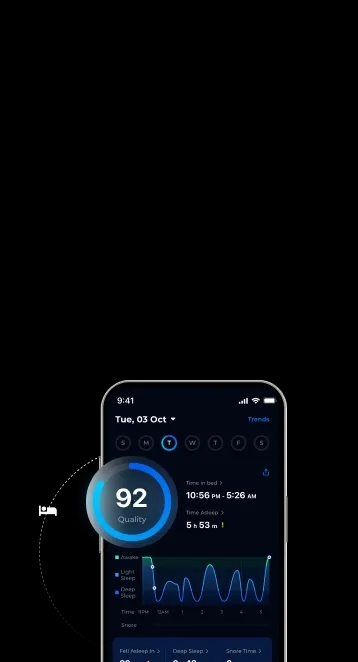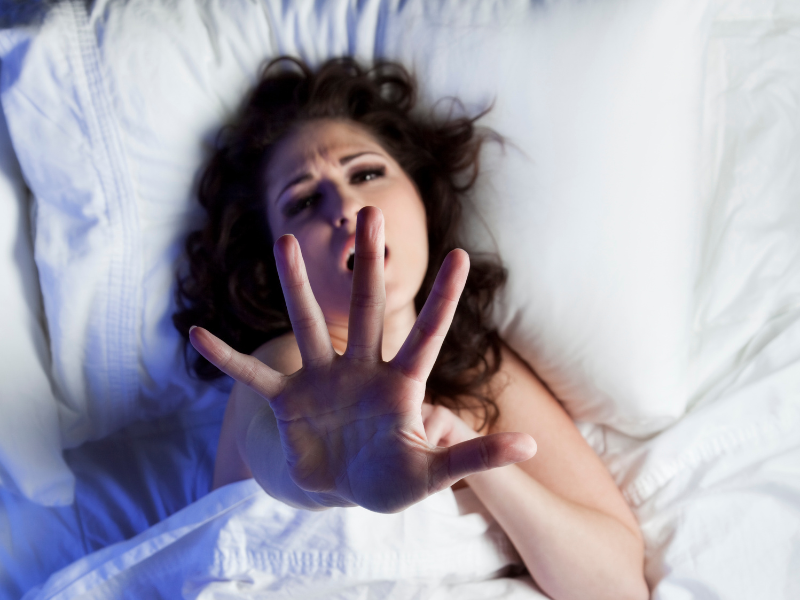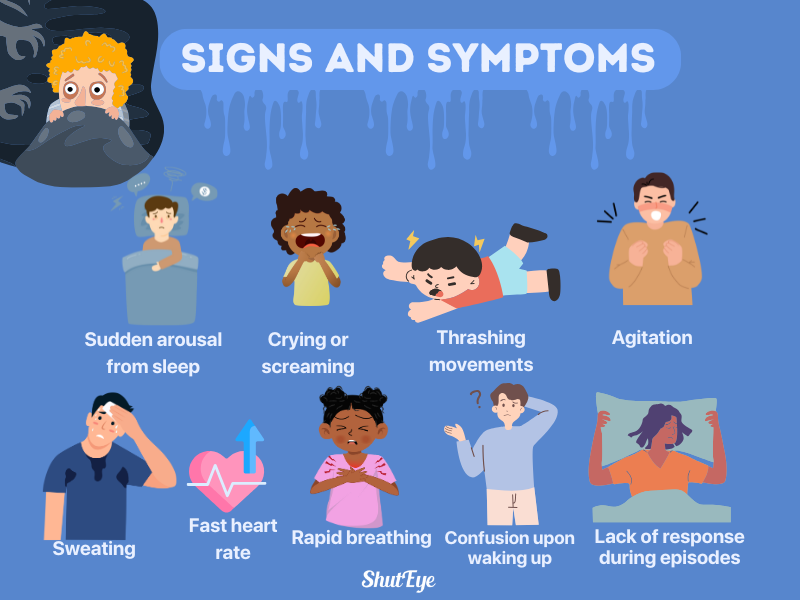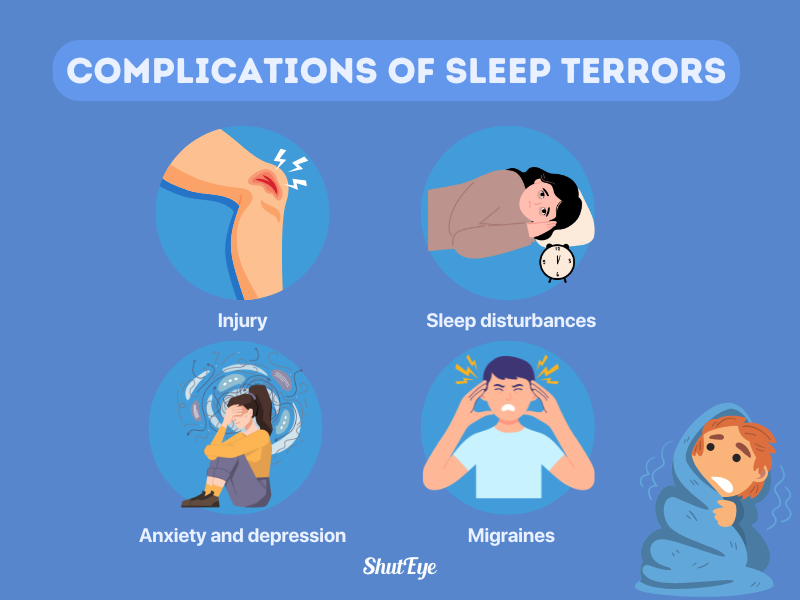


Waking up with intense fear is an undesirable event that no one would like to experience. Sleep terrors, a type of parasomnia, are particularly common in children, affecting about 30% of them [1]. While rare, adults can also experience sleep terrors, often triggered by stress or underlying sleep issues.
Find out what causes sleep terrors, signs and symptoms, and ways to treat and prevent them from occurring.

Sleep terrors, also known as night terrors, are a type of parasomnia in which the sleeper wakes up in a state of intense fear or distress [2].
During an episode, you might not respond to voices, making it hard to wake you up. Additionally, when sleep terrors occur, you may find yourself suddenly sitting up in bed, screaming or shouting incoherent things. You may experience intense fear, sweating, breathing heavily, or feeling your heart racing.
An episode like this often occurs during the deep sleep stage in the Non-rapid eye movement (NREM) sleep stages [3].
The exact cause of night terror episodes is still unknown, but research suggests that night terrors happen due to several potential factors. These potential triggers include developmental aspects, environmental influences, organic factors, psychological conditions, and genetic predispositions [4].
For children, it occurs between the ages of 4 to 12 years old, peaking between 5 to 7 years of age. Many children tend to outgrow night terrors as they grow older and develop mentally and physically.
Children who experience this condition are also more likely to develop sleepwalking and sleeptalking in the later parts of their childhood [4].
Meanwhile, night terrors are less likely seen in adults. If an adult does experience night terrors at night, research points to underlying psychiatric disorders as a cause [4].

The signs and symptoms of sleep terrors include the following [5]:

Some common complications that may arise from sleep terrors include:
Injury: Bodily injury may happen as they may also sleepwalk during episodes [6]
Sleep disturbances: May cause sleep disruptions and awakenings, leading to daytime sleepiness and fatigue [7], [8].
Anxiety and depression: As a result of sleep disruptions and changes in sleep patterns, those with sleep terrors may have elevated scores for anxiety and depression [9].
Migraine: Migraine is associated with sleep terrors due to possible serotonin level disturbances [10].
Sleep terrors can be treated in many different ways. For not-so-severe cases, you would not require any specific medical interventions.
However, if it happens frequently or is more severe, you may be recommended by your healthcare provider to undergo psychotherapy or to take Benzodiazepine medications to suppress stages 3 and four of NREM sleep [11].
Sleep terrors can be easily managed with a few at-home strategies as most times, they would subside on their own.
Some of the strategies include the following:
Sleep terrors are generally harmless and often resolve on their own. Effective strategies for managing them include maintaining a consistent sleep schedule, ensuring a safe sleep environment, and avoiding waking someone mid-episode.
If you suspect you might have parasomnia, consider using the ShutEye® app for a free sleep study and personalized sleep analysis. ShutEye® leverages polysomnography and AI algorithms to accurately monitor sleep patterns.
American Psychiatric Association (2013) Parasomnia. Diagnostic and Statistical Manual of Mental Disorders. 5th ed. Arlington, VA: American Psychiatric Association; 457
Carrillo-Solano, M., Leu-Semenescu, S., Golmard, J., Groos, E., & Arnulf, I. (2016). Sleepiness in sleepwalking and sleep terrors: A higher sleep pressure? Sleep Medicine, 26, 54-59. Available at: https://doi.org/10.1016/j.sleep.2015.11.020
Fialho, L. M. N., Pinho, R. S., Lin, J., Minett, T. S. C., Vitalle, M. S. de S., Fisberg, M., Peres, M. F. P., Vilanova, L. C. P., & Masruha, M. R.. (2013). Sleep terrors antecedent is common in adolescents with migraine. Arquivos De Neuro-psiquiatria, 71(2), 83–86. Available at: https://doi.org/10.1590/S0004-282X2013005000006
John Hopkins Medicine (2024) Nightmares and Night Terrors [online]. Available at: https://www.hopkinsmedicine.org/health/conditions-and-diseases/nightmares-and-night-terrors
Leung AKC, Leung AAM, Wong AHC, Hon KL. Sleep Terrors: An Updated Review. Curr Pediatr Rev. 2020;16(3):176-182. doi: 10.2174/1573396315666191014152136. PMID: 31612833; PMCID: PMC8193803.
Lopez, R., Jaussent, I., and Dauvilliers, Y. (2014) Objective daytime sleepiness in patients with somnambulism or sleep terrors. Neurology Journals, 83 (22) 2070-2076. Available at: https://doi.org/10.1212/WNL.0000000000001019
Moini, J., LoGalbo, A., & Ahangari, R. (2023). Consciousness. Foundations of the Mind, Brain, and Behavioral Relationships, 195-210. Available at: https://doi.org/10.1016/B978-0-323-95975-9.00024-X
Spratt, E. (2024) Sleep Terrors [online]. Available at: https://emedicine.medscape.com/article/914360-overview?form=fpf
Skiba, V. and Morse, A. (2021) Sleep Terrors [online]. Available at: https://sleepeducation.org/sleep-disorders/sleep-terrors/
Van Horn NL, Street M. (2023) Night Terrors [online]. Available from: https://www.ncbi.nlm.nih.gov/books/NBK493222/